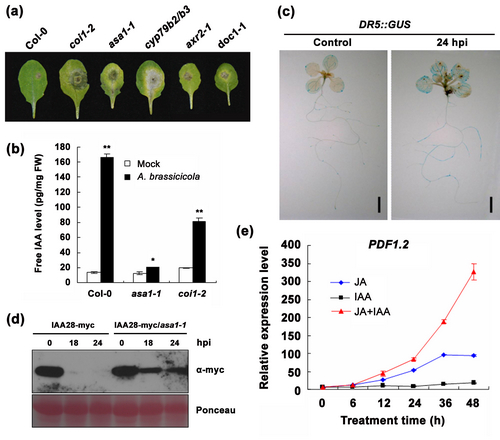Hormone crosstalk plays critical regulatory roles during plant-pathogen interaction. It is generally accepted that SA-mediated resistance is effective against biotrophs and hemi-biotrophs, whereas JA- mediated responses are predominantly effective against necrotrophs.
Studies in the last decade have demonstrated that the plant growth hormone auxin is also involved in the resistance against biotrophic pathogens and acts antagonistically with SA, but in comparison, less is known about the possible roles of auxin during plant-necrotroph interaction and how it interacts with jasmonate.
Researchers in Dr. Chuanyou Li’s group from the Institute of Genetics and Developmental Biology, the Chinese Academy of Sciences, recently demonstrated that auxin also contributes to plant resistance against necrotrophic pathogens.
Arabidopsis thaliana mutants defective in different aspects of the auxin pathway are generally more susceptible than wild-type plants to the necrotrophic pathogen Alternaria brassicicola. Infection with the pathogen activates the transcription of a battery of auxin biosynthetic genes and therefore elevates auxin biosynthesis of host plants. A. brassicicola infection also reduces protein levels of the PIN-FORMED (PIN) family of auxin transporters and therefore reduces auxin transport capacities.
The above-described effects of A. brassicicola infection are partially dependent on JA signaling and together lead to an enhanced auxin response in the host plants. Application of IAA and MeJA together synergistically induces the expression of defense marker genes PDF1.2 and HEL, suggesting that enhancement of JA-dependent defense signaling may be part of the auxin-mediated defense mechanism involved in resistance to necrotrophic pathogens.
This work demonstrates the positive interaction between auxin and jasmonate during plant interaction with necrotrophic pathogens. On one hand, endogenously elevated jasmonate stimulates auxin biosynthesis upon pathogen infection. On the other hand, auxin enhances JA-induced expression of defense-related genes. This work greatly broadens our view about the roles of auxin in plant resistance against necrotrophic pathogens.
The work has been published online in New Phytologist (doi: 10.1111/j.1469-8137.2012.04208.x). The Ph. D. student Linlin Qi from the IGDB and the guest student Jiao Yan from Shandong Agricultural University are the co-first authors. This research was supported by grants from Beijing Natural Science Foundation, the Ministry of Agriculture of China and the National Natural Science Foundation of China.
AUTHOR CONTACT:
Chuanyou Li, Group Leader
Institute of Genetics and Developmetnal Biology, Chinese Academy of Sciences, Beijing, China.
(Image by Linlin Qi et al)
Figure Auxin interacts positively with jasmonate to contribute to Arabidopsis resistance against the necrotrophic pathogen A. brassicicola. (a) Arabidopsis mutants defective in different aspects of the auxin pathway are generally more susceptible than wild-type plants to A. brassicicola. (b) A. brassicicola infection drastically up-regulates free IAA level of host plants partially dependent on JA signaling. (c) A. brassicicola infection enhances auxin response but alters the asymmetric auxin distribution. (d) A. brassicicola infection stimulates the degradation of AUX/IAA auxin signaling repressors. (e) Auxin enhances JA-induced expression of defensive marker gene PDF1.2. “*” indicates p < 0.05 and “**” indicates p < 0.01 in Student’s t test.
 (Image by Linlin Qi et al)Figure Auxin interacts positively with jasmonate to contribute to Arabidopsis resistance against the necrotrophic pathogen A. brassicicola. (a) Arabidopsis mutants defective in different aspects of the auxin pathway are generally more susceptible than wild-type plants to A. brassicicola. (b) A. brassicicola infection drastically up-regulates free IAA level of host plants partially dependent on JA signaling. (c) A. brassicicola infection enhances auxin response but alters the asymmetric auxin distribution. (d) A. brassicicola infection stimulates the degradation of AUX/IAA auxin signaling repressors. (e) Auxin enhances JA-induced expression of defensive marker gene PDF1.2. “*” indicates p < 0.05 and “**” indicates p < 0.01 in Student’s t test.
(Image by Linlin Qi et al)Figure Auxin interacts positively with jasmonate to contribute to Arabidopsis resistance against the necrotrophic pathogen A. brassicicola. (a) Arabidopsis mutants defective in different aspects of the auxin pathway are generally more susceptible than wild-type plants to A. brassicicola. (b) A. brassicicola infection drastically up-regulates free IAA level of host plants partially dependent on JA signaling. (c) A. brassicicola infection enhances auxin response but alters the asymmetric auxin distribution. (d) A. brassicicola infection stimulates the degradation of AUX/IAA auxin signaling repressors. (e) Auxin enhances JA-induced expression of defensive marker gene PDF1.2. “*” indicates p < 0.05 and “**” indicates p < 0.01 in Student’s t test. CAS
CAS
 中文
中文




.png)
